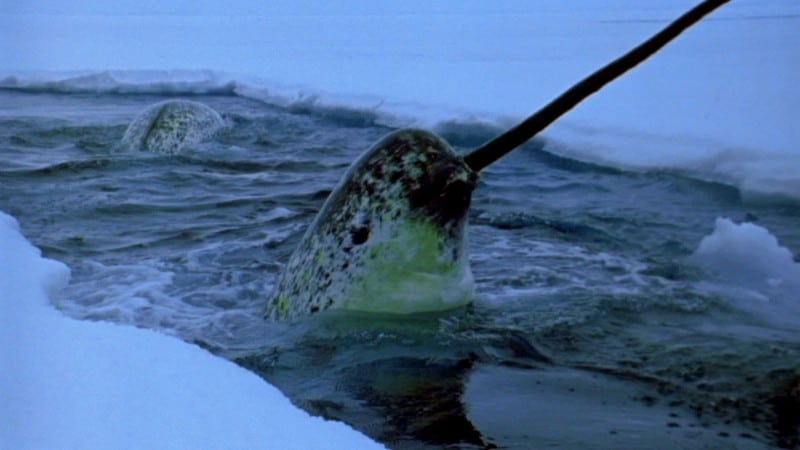
Narwhal Facts
- Firstly, the rather remarkable Narwhal, Monodon monoceros, sometimes called the narwhale, ranks as a medium-sized toothed whale and the animal with the largest canines on the planet.
- The mammal also grows to be a medium-sized whale, or around the same size as related species. Total length in both sexes, excluding the tusk of the male, can range from 13-18 ft. (4-5.5 m).
- In addition, typical adult body weight measures between 1,800-3,500 lbs (800-1,600 kg).
- Males attain sexual maturity at 11 to 13 years of age, when they reach roughly 13 ft (4 m) in length, while females do so at 5 to 8 years old when they reach about 11 ft (3.3 m) long.
Related Articles
Narwhal Physical Description
Most notably, the pigmentation of the Narwhal develops as a mottled pattern, with blackish-brown markings over a white background, unlike any other species of whale in any ocean.
The coloring of the creature also appears darkest at birth, becoming whiter in color with age. White patches develop on the navel and genital slit at sexual maturity. Old males may also be almost pure white.
Narwhals do not have a dorsal fin – possibly an evolutionary adaptation to swimming easily under ice. In addition, the neck vertebrae do not fuse together but stay jointed, like those of land mammals. Both these characteristics are shared by the beluga whale, a fellow inhabitant of icy Arctic seas.
While the tail flukes of female narwhals have front edges that sweep back, those of males have front edges that are more concave and lack a sweepback. This is an adaptation for reducing drag caused by the tusk.
- Kingdom: Animalia
- Phylum: Chordata
- Class: Mammalia
- Order: Artiodactyla
- Family: Monodontidae
- Genus: Monodon
- Species: M/monoceros
Narwhal Tusks
Firstly, the most conspicuous characteristic of the male narwhal remains its single extremely long tusk. Further, this actually represents a canine tooth that projects from the left side of the upper jaw, through the lip and forms a left-handed helix.
The tusk also grows throughout life reaching lengths of as much as 10 ft (3.1 m). Despite its rather formidable appearance, the tusk is hollow and weighs only about 22 lbs (10 kg).
About one in 500 males has two tusks, which occurs when the right canine, normally small and less straight, also grows out through the lip.
Females may grow tusks sometimes, although the evidence on the frequency of this is somewhat conflicting. The tusks are surrounded posteriorly, ventrally, and laterally by several small teeth which vary in morphology and histology.
These teeth are vestigial and never erupt from the lip, as such the Narwhal’s mouth appears toothless.
Narwhal Distribution, Habitat, and Ecology
The animal inhabits predominantly the Atlantic and Russian areas of the Arctic Ocean. Individuals also commonly appear in the northern part of Hudson Bay, Hudson Strait, and the Baffin Bay – off the east coast of Greenland.
The Narwhal often visits a strip running east from the northern end of Greenland round to eastern Russia. Additionally, the northernmost sightings of narwhal have occurred north of Franz Joseph Land.
Also, most of the world’s narwhals inhabit the fjords and inlets of Northern Canada and western Greenland.
Individuals remain able to survive diving to rather incredible depths of up to 4,900 ft (1,500 m) below sea level.
The Narwhal also has a relatively restricted and specialized diet. Its prey predominantly includes halibut, cod, shrimp, cuttlefish, and arm hook squid. Additional items found in its stomach have included capelin, wolffish, and sometimes rocks, accidentally ingested when whales feed near the bottom.
Due to the lack of well-developed dentition in the mouth, Narwhals most likely feed by swimming towards prey until it is within close range and then sucking it with considerable force into the mouth.
Species Sharing Its Range
Check out our other articles on Ocean Conservation, Dugong, West Indian Manatee, Table Mountain, Western Juneberry, Evening Cicada, European Lobster, Axolotl, Australian Sea Lion
